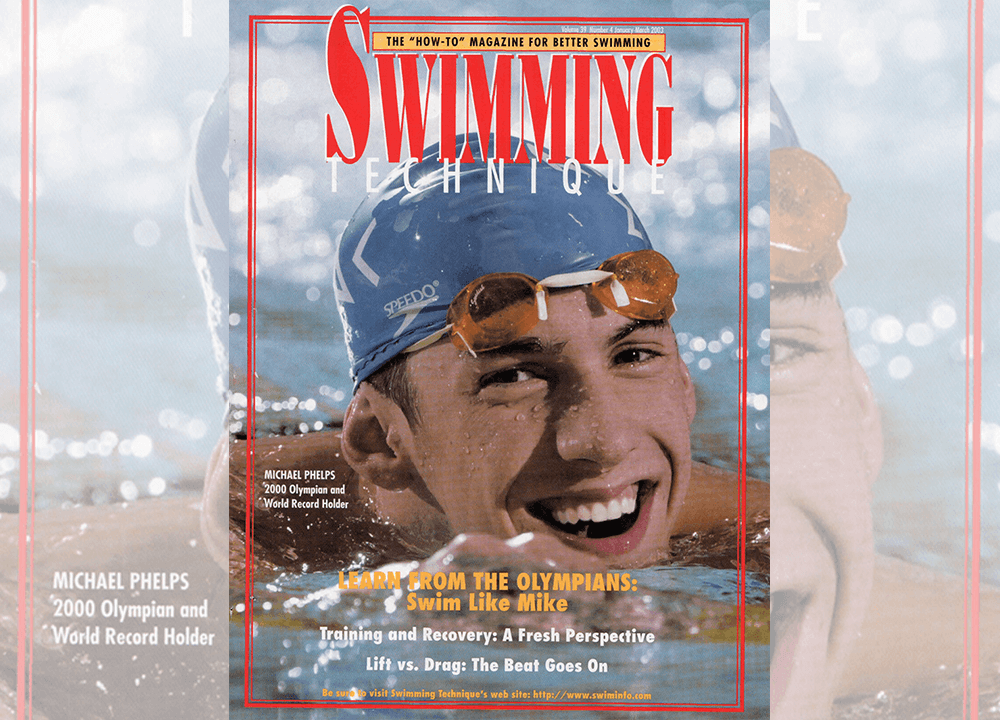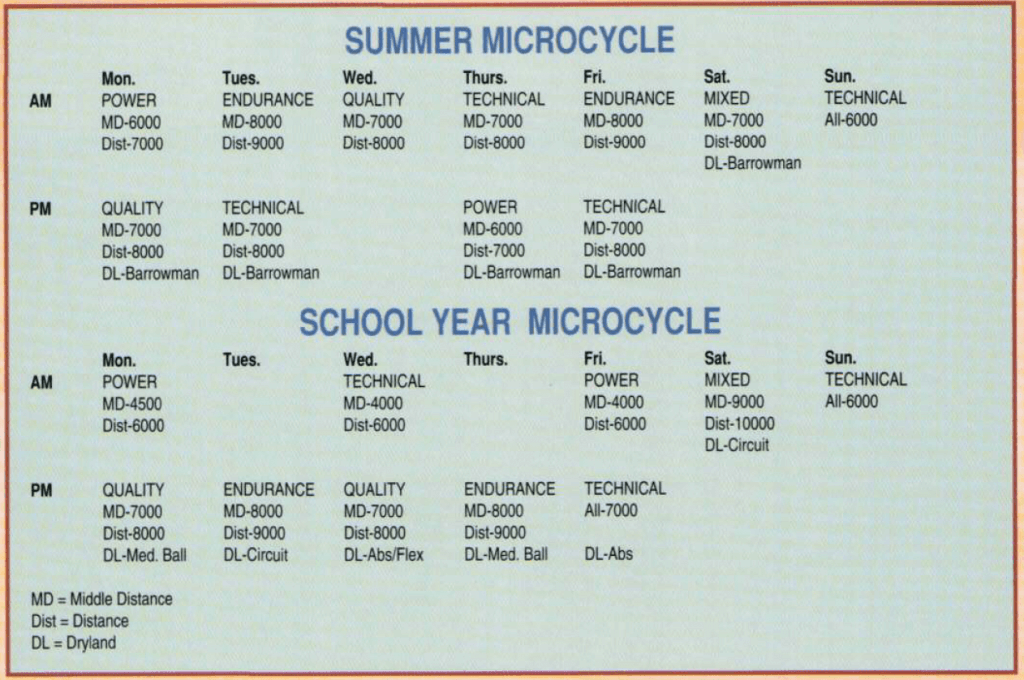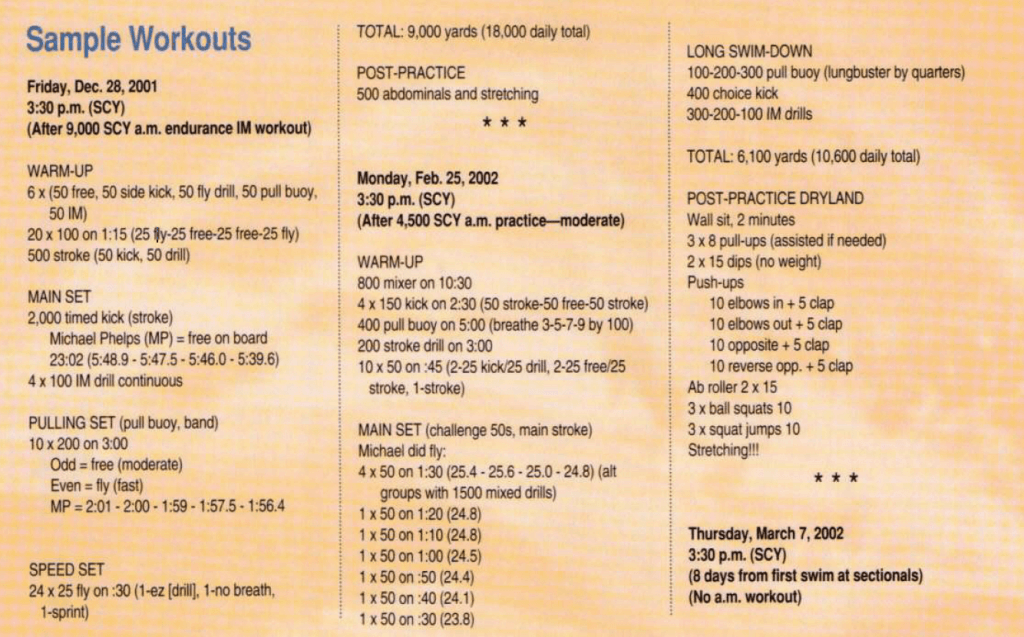Throwback Thursday: The Early Training That Led Michael Phelps and Bob Bowman to Hall of Fame (Sample Sets)

Throwback Thursday: The Early Training That Led Michael Phelps and Bob Bowman to Legendary Status (Sample Sets)
Together, Michael Phelps and Bob Bowman forged the most successful athlete-coach relationship in the history of the sport. Here is a look at some of the early workouts that led to Phelps’ stardom.
************************************************
By Bob Bowman (with Michael J. Stott) – From 2003
I think it was pretty clear from the beginning that Michael Phelps was a special swimmer. When he joined us at North Baltimore Aquatic Club as a 7-year-old, he was a baseball/soccer/lacrosse athlete. His first year, he just did a 60-minute, once-a-week stroke clinic with our aquatics director, Cathy Lears.
His training and intensity escalated from there, to where, by the time he was 10 and setting NAG records, he was better than many of the older swimmers. Obviously, we had to do some rapid lane promotions.
To those who knew the Phelps aquatic heritage, his prowess was no surprise. His oldest sister, Hilary Phelps, was a national-level swimmer. His second sister, Whitney Phelps, was also a 200 flyer. She made the 1994 World Championship team that competed in Rome. (She still held the 11-12 NAG record in the 100 yard fly at the time this article was printed.) So, in many ways, swimming excellence has been a family trait.
And while it is also tempting to think of Michael only in terms of the fly and IM, a review of his record reveals a litany of national rankings in the free and back as well.
Supportive parents have aided his climb immensely. They had been through the drill with the older daughters. Then there’s Michael’s physique: at 6-4, he is mostly torso with a large chest and long arms. It’s a body great for swimming. He is very flexible throughout the shoulders, upper body and especially in the ankles.
Michael is much more disciplined than he was in his earlier days. He was, and is still, a pretty strong-willed kid. Back then, he didn’t understand he might have to do some things he didn’t want to do, like train, sit still, pay attention and not talk. He was very energetic as a young boy.
These days, he’s modified his behavior – either voluntarily or involuntarily.
“I think part of that modification started when I pulled him out of the pool and told him, ‘You’ve got a stroke that is going to set a world record some day, and you are going to do it in practice.'” – Bob Bowman
Keenly Competitive
Michael has an athletic mentality second to none. He is keenly competitive and that’s what drives him. In competition, he is incredibly focused and able to relax. The higher the level of competition, the better he is. That’s something you just don’t see very often.
What he needs to work on is the same thing he had to work on as a child: to strengthen the connection in his mind between what happens on a daily basis and how that affects what’s going to happen when he gets in the big meet.
He’s better now and better than 90 percent of the the population, but he still has those days – about once every six weeks – when he’s tired, and it’s a struggle for me to get him to do things and maintain the same intensity in workout that he gives in the big meets.
In 2002, he had an excellent summer, setting a world record in the 400 meter IM, taking four events at the Phillips 66 Summer Nationals, notching American records in the 200 IM and 100 fly and swimming the fastest fly leg ever in a 4 x 100 world record medley relay victory.
In addition to water work, we religiously incorporated a “Mike Barrowman medicine ball routine” into his dryland routine, and we did a three-week stay at altitude in Colorado Springs. He’s followed his long course success with the best fall and winter he’s ever had by far.
Typically, for the last three or four years, Michael has had very good summers. Then there have been down periods in the fall where we’ve had to work hard to crank him back up to a good mental mode.
That has not been the case this year. This fall and winter, Michael has worked hard on the backstroke. In fact, he’s gotten really good. Recently, he finished a 15 x 200 yard back set with a 1:45. Not too bad! And his breaststroke, while still not flashy, is greatly improved.
We continue to develop Michael as a complete swimmer. That means some emphasis on the distance freestyle. On Halloween, he whipped off a 5,000 free for time in a 46:34. That’s under a 9:20 per 1,000 average. I was impressed with that. In fact, it is probably the most impressive thing he’s done, and it might be one of the most impressive things he ever does.
That’s the kind of thing I’m not sure you can ever replicate, but it’s neat to give him some confidence, particularly since he has to swim against some of the super distance guys.
This is the third year we have approached the training cycle from a yearly perspective. It’s not our style at NBAC to talk about the results of success.
We are always interested in the process. Michael didn’t understand the scope of it until his breakout spring nationals performance in Seattle in 2000 when he went from a 2:04.68 to 1:59-flat and set a 15-16 NAG record in the 200 meter fly. After that, the secret was out.
Setting Goals
These days, Phelps sets goals for himself. Our eyes are on one medium and one long-range goal: World Championships in July in Barcelona and 2004 Olympic Trials and Games.
In Spain, he will swim a full program that mimics the Olympic schedule, except that, there the 400 IM, will be on the last day rather than the first. That’s a full plate: six days of prelims, semis and finals in the 100-200 fly, 200-400 IM, 800 free relay, 400 medley relay and, hopefully, a berth on the 4 x 100 free relay.
To get ready for that, we have concocted a training program that began with a fairly high-mileage fall, a 70-80,000 mixture of yards and meters per week.
There was also 30-45 minutes of dryland six days a week. September through December, we focused on structural adaptation.

Photo Courtesy: Swimming Technique Magazine
With that, we are looking to stimulate major physiological growth that will make him go faster. At this stage, we don’t emphasize fine-tuning. Instead, we have spent a lot of time on endurance work, improving technical issues and gaining strength–putting money in the bank.
We’ll continue that regimen through spring nationals. From April through May, we’ll focus on functional adaptation, working on coordination plus speed and racing-specific elements for the World Championships. With all his success, it is easy to overlook that Michael Phelps is only a 17-year-old, especially given that he is in his second year as a professional and drives a Cadillac Escalade.
But, he’s earned it, and he’s in the process of maturing and securing his financial future. This spring, he’ll graduate from Towson High School. In the fall, he’ll be attending classes at Loyola College in Baltimore and continue to train with us at North Baltimore.
Check the accompanying charts for some typical early-mid. and late-season workouts Michael Phelps has done during the 2001-2002 short and long course seasons.

Photo Courtesy: Swimming Technique Magazine
Note from the Publisher: When this article was published in 2003, Bob Bowman was the senior coach at the North Baltimore Aquatic Club in Maryland. Bowman is now the head coach at the University of Texas. Michael Phelps is retired as the greatest Olympic athlete of all time, winning 28 Olympic medals.




As I go start 2023 following these workouts